Land Cruiser Admiral Byrd
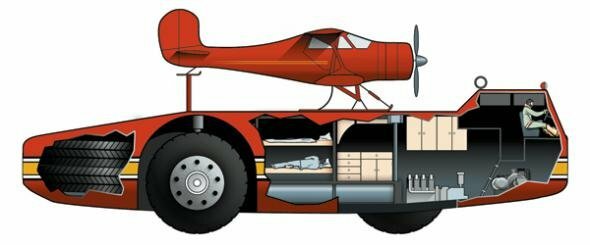
This story 70 happened exactly 10 years ago, and in Europe it was not really noticed: World War II was already under way. And the end of a unique Antarctic all-terrain vehicle the size of a cruiser was sad: he ... drowned. Or maybe, by the way, he did not drown. But to return now to the bygone days is already due to the fact that technologies that are just being introduced today have been used in the construction of a giant car.
The light went out, flashed the first footage of the old chronicle: 1934 year, in the icy wilderness of Antarctica, the brave polar explorer, rear admiral Richard Baird, fatefully awaits death in a hut, cut off from the whole world by the terrible weather, which in these places at the South Pole happens regularly. Again and again, his friend and deputy professor, Thomas Poulter, is trying to break through the 123 miles to the admiral on snowmobile tractors. And finally, the third attempt is crowned with success, although there is almost no power left for the rescuers and the rescuers. The end, captions.
It was in 1934 that Poulter decided to create a specialized vehicle for a trip to the pole, which would not be afraid of snow storms, 80-degree frosts, or treacherous bottomless cracks covered with a thin layer of frozen snow (firn). The engine and crew had to be protected from the weather and cold, and people had to have enough space for a long (weeks and months) stay in the car, the car itself should be noticeably longer than the width of the middle crevice, otherwise it would fail.
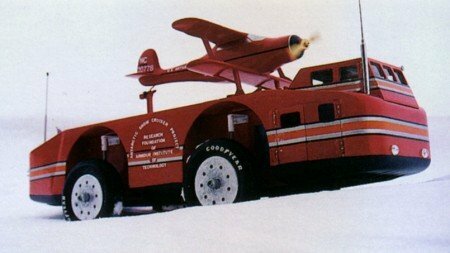
Poulter was a typical American, that is, not only a physicist scientist, but also a resourceful businessman. In any case, he convinced Congress that such a Snow Cruiser (“Snow Cruiser”) could not only be built, but also needed, and the whole undertaking would cost some 150 000 dollars, which would also come from private investors. From the government, Poulter asked nothing: to pay the costs of the expedition itself and the transfer of the Leviathan to Antarctica and back.
Imperialism Impact Building
The construction of the Snow Cruiser began on 8 August 1939 of the year at the Pullmann plant in Chicago, and the construction of the entire port, tests and delivery to the port took ... 11 weeks! October 24 cruiser was almost ready. In any case, so much so that under its own power it would be possible to launch 17 00 kilometers into Boston for loading onto the ship North Star ("Polar Star"). Be late for November 15 - and all, another unique expedition of Admiral Byrd would have failed. Just imagine: on the highway a bright red 34-ton monster with a length of 17 meters, a height of 4,9 meters and a width of 6 meters.
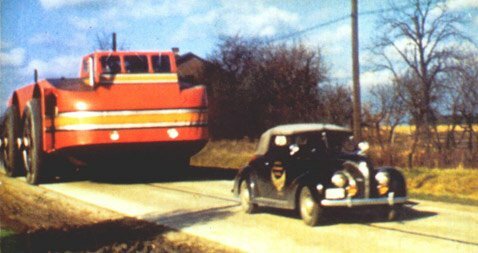
November 1 1939 of the year. A rare color shot: The Cruiser enters Ohio
It was necessary to block the movement and disperse the crowds of curious, literally rushed under the huge three-meter wheels.
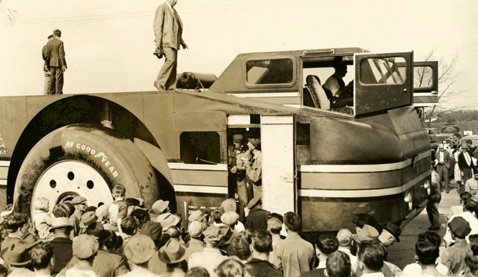

This run was the only running test of the Snow Cruiser, which played a cruel joke on him in Antarctica. The snow turned out to be quite different in properties on asphalt.
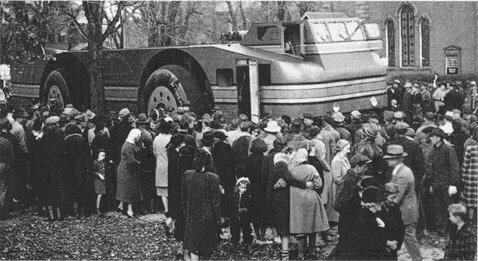
Wherever Antarctic Snow Cruiser drove on his way to Boston, he was always met by enthusiastic crowds.
100 years old super technology
How to rotate a wheel with a diameter of three meters? There was nothing to think about leading to each cardan shaft - all the mechanisms had to be hidden inside the case, so that they could be repaired without leaving the cold. Moreover, all four wheels could turn for the sake of maneuverability, so that the “cruiser” could sail along the snowy surface not only forward or backward, but also at an angle.
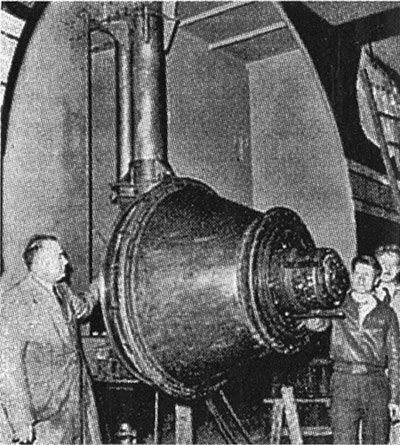
The creators used the diesel-electric scheme: two engines for 150 l. with. rotated the rotors of the two generators, and the wheels were driven into rotation embedded in each (enough space) electric motors for 75 l. with. It seems to you that for such a colossus silenok is clearly not enough? But for some reason, designers didn’t seem so, but in vain ... However, on the highway, the Snow Cruiser developed 48 km / h. Why does he need more? Motors and so turned out to be extremely voracious, at least it's good that you could take 9463 liters of diesel in huge tanks (this should have been enough for 8000 kilometers). And, by the way, inside this monster a crew of five people and Labrador Navi could live in the autonomous mode for a whole year - there would be enough food and heat. Another feature of the “cruiser” is the wheel retracting to the 1,2 meter: this was necessary, in particular, to overcome the wide crevices.
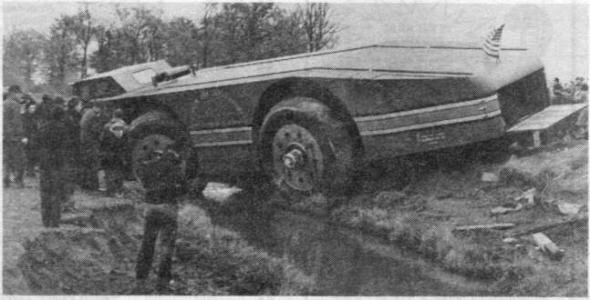
This is how the cruiser had to overcome a crack up to 15 feet wide: the rear wheels were pushing its nose with the front wheels pulled in. Then the rear ones were pulled in, and the front ones, on the contrary, were released and the car was taken “to the other bank”. The procedure involved 20 operations and was time consuming in the absence of computers.
Collapse of hope
January 12 The Polar Star anchored in Whale Bay. And so that the Cruiser was able to leave the board, a special ramp was built from heavy wood, which began to fall apart during unloading, so that only the skill of Poulter, who sat behind the wheel and gave the full throttle at the right moment, allowed the monster to move to safe ice.
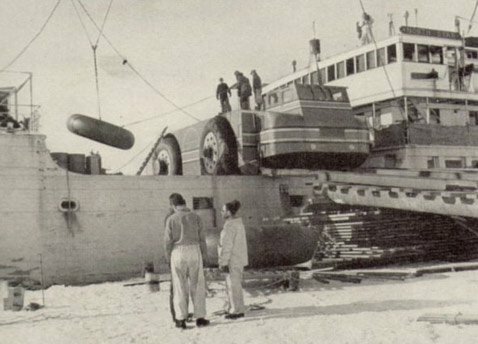
Unloading in Antarctica
We will not describe all the vicissitudes of the Snow Cruiser unloading in Antarctica, let us just say that the wheels of a heavy car, plunging into snow more than 0,9 meters, began to roll helplessly, and the engines overheated. The snow, unlike asphalt, was buried, and the wheels were all the time in the pit, and there was not enough power to go out of it. The only opportunity to go at least 148 kilometers was ... reversing (thanks to the "correct" weight distribution of the bow and stern, as well as the bottom profile and overhangs).
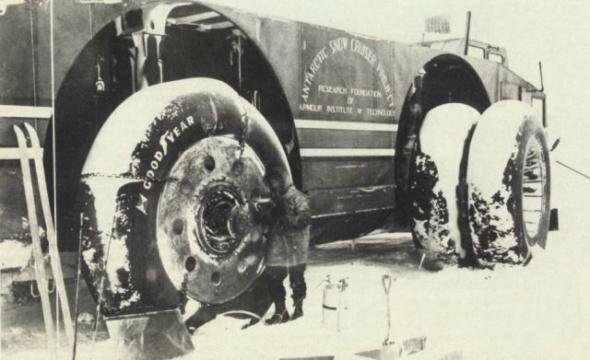
However, the existence in cozy cabins along with warm diesel engines turned out to be very comfortable, and the cruiser embarked on an eternal joke as a base for polar explorers. Expedition scientists even conducted a small series of scientific experiments. Then it was covered with snow, and only a long bamboo pole betrayed the place of the “underground” camp.
Then the war pushed the polar research into the background, and only in 1958, scientists from the international organization IGY found the exact location of the Cruiser, went to Antarctica and dug up the car, saw it and left.
It remains only to guess what happened after that with an extraordinary vehicle. Its approximate location is known, but no one has ever found the Snow Cruiser again. And, perhaps, not looking.
According to one version, the car turned out to be on a floating ice floe, went out on it into the sea and drowned. Another, more intriguing option for Americans is the possible entry of the Cruiser into the hands of the USSR, and they drove a car to explore Siberia. In any case, so wrote some newspapers of that time. Which, of course, is extremely unlikely, because the Russians had to face the same difficulties as they were exported from the United States when exporting a car.
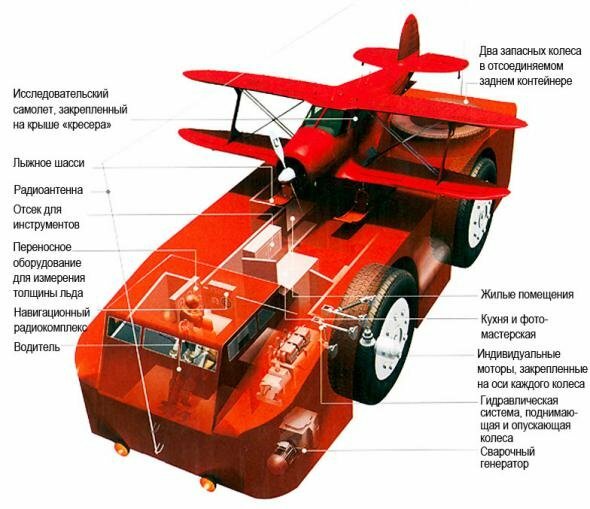
The car was red in order to be clearly visible in Antarctica
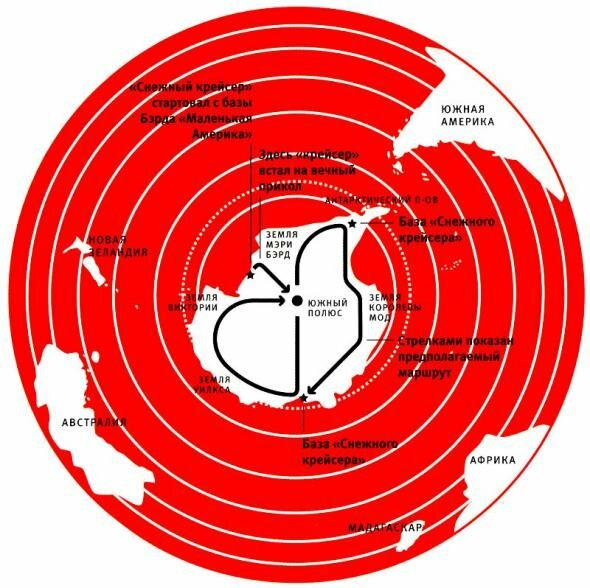
Unless it was possible not to give money for the construction of a “cruiser”, which had to cross the whole of Antarctica up and down (see arrows). Must, but not crossed. In the Antarctic snow he was able to drive barely a hundred and fifty kilometers - from the base of Little America (“Little America”) to the first turn of the route, and even then in reverse.
Information